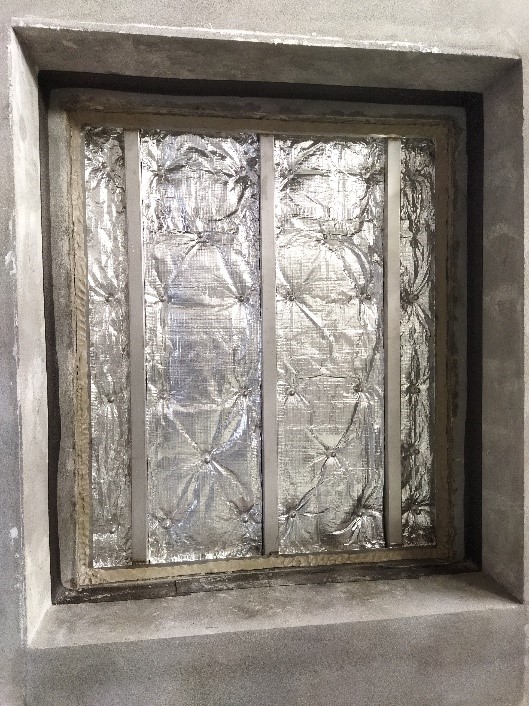ACOUSTIC TESTS IN THE RAILWAY SECTOR
(Pubbl. 26/06/2024)The main activities carried out in our acoustics laboratory for the railway sector are as follows
In both cases, instrumental tests must be carried out on a reference sample of the equipment concerned.
Specifically, the laboratory tests for determining the absorption In particular, the laboratory tests for de-termining the absorption and insulation properties are carried out in accordance with the UNI EN 16272 - 1, UNI EN 16272 - 2 standards and provide for the realisation of a sample with specific dimensions and characteristics defined by the standard, suitable for obtaining results representative of the performance of the device (e.g. the tested configuration must include the upright position).
The test methods refer to UNI EN ISO 354 for absorption and UNI EN ISO 10140 for insulation.

Example of sound absorption test set-up (courtesy of Tecnoacustica)
The reference standards are UNI EN 16272-6 for sound insulation (to be carried out both on the acoustic element and on the support) and UNI EN 16272-5 for sound reflection.
The application of both standards involves the use of a test method known as the “Adrienne method”, which involves the use of a one-way sound source, a grid of 9 equally spaced microphones and very narrow analysis windows.
When testing such elements, the wall cavity is adapted to the specific shape and size of the sample.
The test method is the same as that described above for noise barriers.

Photographic documentation of an internal panel test (thanks to Six Italia)
 To see all our activities in the railway sector, see also our dedicated page “Laboratory tests in the railway sector”.
To see all our activities in the railway sector, see also our dedicated page “Laboratory tests in the railway sector”.
- Characterisation of the acoustic performance of railway noise reduction devices (noise barriers);
- Determination of the sound insulation provided by the components of railway trainsets (interior and exterior panels, windscreens and side windows).
In both cases, instrumental tests must be carried out on a reference sample of the equipment concerned.
1. Laboratory tests on railway noise reduction devices
The acoustic performance of railway noise barriers is determined in accordance with the UNI EN 16272 series of standards.Specifically, the laboratory tests for determining the absorption In particular, the laboratory tests for de-termining the absorption and insulation properties are carried out in accordance with the UNI EN 16272 - 1, UNI EN 16272 - 2 standards and provide for the realisation of a sample with specific dimensions and characteristics defined by the standard, suitable for obtaining results representative of the performance of the device (e.g. the tested configuration must include the upright position).
The test methods refer to UNI EN ISO 354 for absorption and UNI EN ISO 10140 for insulation.
Railway noise barriers: how is the test carried out?
In the insulation test, the sample is placed vertically in a wall cavity that separates the two test chambers. The sound insulation value is obtained from the difference between the sound levels measured in the two chambers when high sound levels are generated in one of them by an isotropic sound source. The in-sulation values thus obtained must comply with the lower limit (30 dB) specified in the General Technical Specifications for RFI.Determination of sound absorption
Sound absorption is determined in the reverberation room by the difference between the equivalent ab-sorption areas calculated with the sample present and without the sample present; these equivalent ab-sorption areas are determined on the basis of the reverberation times measured, the volumes involved and the environmental conditions prevailing during the measurements. The values obtained in each of the 1/3 octave bands must comply with the lower limits specified in the General Technical Specifications for Medi-um and High Performance Soundproofing Panels.
Example of sound absorption test set-up (courtesy of Tecnoacustica)
On-site tests using the Adrienne method
In situ tests are carried out on the barriers at the installation site or on suitable samples set up in the open air to simulate the actual installation conditions.The reference standards are UNI EN 16272-6 for sound insulation (to be carried out both on the acoustic element and on the support) and UNI EN 16272-5 for sound reflection.
The application of both standards involves the use of a test method known as the “Adrienne method”, which involves the use of a one-way sound source, a grid of 9 equally spaced microphones and very narrow analysis windows.
2. Laboratory tests on train components
The determination of the soundproofing performance of the elements that make up the train is carried out by means of laboratory tests in accordance with the UNI EN ISO 10140 series of standards, on small samples (this is generally the case for the panels that make up the internal or external partitions) or full-scale samples (this is the case for glass surfaces such as side windows and windscreens).When testing such elements, the wall cavity is adapted to the specific shape and size of the sample.
The test method is the same as that described above for noise barriers.

Photographic documentation of an internal panel test (thanks to Six Italia)










 Do you need more information about our services?
Do you need more information about our services?